
Bamberg Cathedral
Encyclopedia
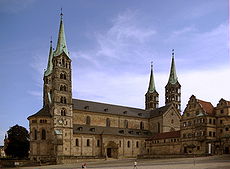
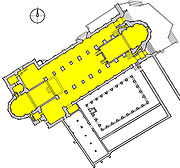
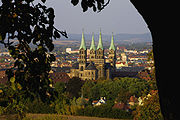
Bamberg
Bamberg is a city in Bavaria, Germany. It is located in Upper Franconia on the river Regnitz, close to its confluence with the river Main. Bamberg is one of the few cities in Germany that was not destroyed by World War II bombings because of a nearby Artillery Factory that prevented planes from...
, Germany
Germany
Germany , officially the Federal Republic of Germany , is a federal parliamentary republic in Europe. The country consists of 16 states while the capital and largest city is Berlin. Germany covers an area of 357,021 km2 and has a largely temperate seasonal climate...
, completed in the 13th century. The cathedral is under the administration of the Roman Catholic Church
Roman Catholic Church
The Catholic Church, also known as the Roman Catholic Church, is the world's largest Christian church, with over a billion members. Led by the Pope, it defines its mission as spreading the gospel of Jesus Christ, administering the sacraments and exercising charity...
and is the seat of the Archbishop of Bamberg.
The cathedral
Cathedral
A cathedral is a Christian church that contains the seat of a bishop...
is a late Romanesque
Romanesque architecture
Romanesque architecture is an architectural style of Medieval Europe characterised by semi-circular arches. There is no consensus for the beginning date of the Romanesque architecture, with proposals ranging from the 6th to the 10th century. It developed in the 12th century into the Gothic style,...
building with four imposing towers. It was founded in 1004 by the emperor Henry II
Henry II, Holy Roman Emperor
Henry II , also referred to as Saint Henry, Obl.S.B., was the fifth and last Holy Roman Emperor of the Ottonian dynasty, from his coronation in Rome in 1014 until his death a decade later. He was crowned King of the Germans in 1002 and King of Italy in 1004...
, finished in 1012 and consecrated on May 6, 1012. It was later partially destroyed by fire in 1081. The new cathedral, built by St. Otto of Bamberg
Otto of Bamberg
Saint Otto of Bamberg was a medieval German bishop and missionary who, as papal legate, converted much of Pomerania to Christianity.-Life:Otto was born into a noble family in Mistelbach, Franconia...
, was consecrated in 1111, and in the 13th century received its present late-Romanesque form.
The cathedral is about 94 m long, 28 m broad, 26 m high, and the four towers are each about 81 m high. Of its many works of art may be mentioned the magnificent marble tomb of the founder and his wife, the empress Cunigunde, considered the masterpiece of the sculptor Tilman Riemenschneider
Tilman Riemenschneider
Tilman Riemenschneider was a German sculptor and woodcarver active in Würzburg from 1483. He was one of the most prolific and versatile sculptors of the transition period between late Gothic and Renaissance, a master in stone and limewood.- Biography :Tilman Riemenschneider was born between 1459...
, and carved between 1499 and 1513.
Another treasure of the cathedral is an equestrian statue known as the Bamberg Horseman
Bamberg Horseman
The Bamberg Horseman is a life-size stone equestrian statue by an anonymous medieval sculptor in the cathedral of Bamberg, Germany.Dating probably from the time before the consecration of the cathedral's new building in 1237, but after 1225, it is located on a console at the north pillar of the St...
. This statue, possibly depicting the Hungarian king Stephen I, most likely dates to the period from 1225 to 1237.
Construction

Cathedral
A cathedral is a Christian church that contains the seat of a bishop...
was founded in 1004 by the emperor Henry II, and was consecrated in 1012. During the next two centuries
Century
A century is one hundred consecutive years. Centuries are numbered ordinally in English and many other languages .-Start and end in the Gregorian Calendar:...
it was burnt down twice. The building we now see is a late Romanesque
Romanesque architecture
Romanesque architecture is an architectural style of Medieval Europe characterised by semi-circular arches. There is no consensus for the beginning date of the Romanesque architecture, with proposals ranging from the 6th to the 10th century. It developed in the 12th century into the Gothic style,...
building with four big towers. It has a choir at both ends. The east chancel is dedicated to St. George. This symbolizes the Holy Roman Empire
Holy Roman Empire
The Holy Roman Empire was a realm that existed from 962 to 1806 in Central Europe.It was ruled by the Holy Roman Emperor. Its character changed during the Middle Ages and the Early Modern period, when the power of the emperor gradually weakened in favour of the princes...
. The west chancel is dedicated to St. Peter symbolizing the Pope
Pope
The Pope is the Bishop of Rome, a position that makes him the leader of the worldwide Catholic Church . In the Catholic Church, the Pope is regarded as the successor of Saint Peter, the Apostle...
.
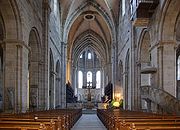
Gothic architecture
Gothic architecture is a style of architecture that flourished during the high and late medieval period. It evolved from Romanesque architecture and was succeeded by Renaissance architecture....
ones. Between these two styles is the Transitional style, and this is the style which is characteristic of the nave
Nave
In Romanesque and Gothic Christian abbey, cathedral basilica and church architecture, the nave is the central approach to the high altar, the main body of the church. "Nave" was probably suggested by the keel shape of its vaulting...
.
Sculptures and carvings
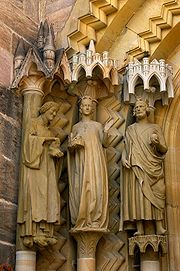
Sculpture
Sculpture is three-dimensional artwork created by shaping or combining hard materials—typically stone such as marble—or metal, glass, or wood. Softer materials can also be used, such as clay, textiles, plastics, polymers and softer metals...
s in the cathedral. One of the most magnificent ones is the marble
Marble
Marble is a metamorphic rock composed of recrystallized carbonate minerals, most commonly calcite or dolomite.Geologists use the term "marble" to refer to metamorphosed limestone; however stonemasons use the term more broadly to encompass unmetamorphosed limestone.Marble is commonly used for...
tomb of Henry II, the founder of the cathedral, and his wife, the empress Cunigunde. It took the famous sculptor Tilman Riemenschneider
Tilman Riemenschneider
Tilman Riemenschneider was a German sculptor and woodcarver active in Würzburg from 1483. He was one of the most prolific and versatile sculptors of the transition period between late Gothic and Renaissance, a master in stone and limewood.- Biography :Tilman Riemenschneider was born between 1459...
14 years to carve: between 1499 and 1513. The tomb is slightly higher than floor level because below there is a crypt
Crypt
In architecture, a crypt is a stone chamber or vault beneath the floor of a burial vault possibly containing sarcophagi, coffins or relics....
. The carvings round the side tell of various episodes in the lives of the imperial couple.
There is a beautiful Nativity altar in the south transept made in limewood by the famous artist Veit Stoss
Veit Stoss
Veit Stoss was a leading Bavarian sculptor, mostly in wood, whose career covered the transition between the late Gothic and the Northern Renaissance. His style emphasized pathos and emotion, helped by his virtuoso carving of billowing drapery; it has been called "late Gothic Baroque"...
. He made it when he was about 80 years old. His son asked him to build it. His son was a Carmelite prior
Prior
Prior is an ecclesiastical title, derived from the Latin adjective for 'earlier, first', with several notable uses.-Monastic superiors:A Prior is a monastic superior, usually lower in rank than an Abbot. In the Rule of St...
in the nearby city of Nürnberg
Nuremberg
Nuremberg[p] is a city in the German state of Bavaria, in the administrative region of Middle Franconia. Situated on the Pegnitz river and the Rhine–Main–Danube Canal, it is located about north of Munich and is Franconia's largest city. The population is 505,664...
. Unfortunately he was expelled from Nürnberg because he was against the Protestant
Protestantism
Protestantism is one of the three major groupings within Christianity. It is a movement that began in Germany in the early 16th century as a reaction against medieval Roman Catholic doctrines and practices, especially in regards to salvation, justification, and ecclesiology.The doctrines of the...
s at the time of the Reformation
Protestant Reformation
The Protestant Reformation was a 16th-century split within Western Christianity initiated by Martin Luther, John Calvin and other early Protestants. The efforts of the self-described "reformers", who objected to the doctrines, rituals and ecclesiastical structure of the Roman Catholic Church, led...
. This meant that his father was never paid for his beautiful work, which was soon moved to Bamberg.
The Bamberger Reiter
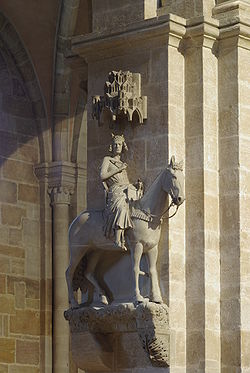
Romanticism
Romanticism was an artistic, literary and intellectual movement that originated in the second half of the 18th century in Europe, and gained strength in reaction to the Industrial Revolution...
s thought he was a German emperor from the Hohenstaufen
Hohenstaufen
The House of Hohenstaufen was a dynasty of German kings in the High Middle Ages, lasting from 1138 to 1254. Three of these kings were also crowned Holy Roman Emperor. In 1194 the Hohenstaufens also became Kings of Sicily...
family. The Nazi
Nazism
Nazism, the common short form name of National Socialism was the ideology and practice of the Nazi Party and of Nazi Germany...
s thought he was a knight who symbolized German perfection, looking towards the east for new lands to conquer. This was Nazi propaganda
Propaganda
Propaganda is a form of communication that is aimed at influencing the attitude of a community toward some cause or position so as to benefit oneself or one's group....
. The knight on the statue does not, in fact, look east at all. It is now thought that he was probably the 11th century Hungarian
Hungary
Hungary , officially the Republic of Hungary , is a landlocked country in Central Europe. It is situated in the Carpathian Basin and is bordered by Slovakia to the north, Ukraine and Romania to the east, Serbia and Croatia to the south, Slovenia to the southwest and Austria to the west. The...
king Stephen I.. Modern technology has made it possible for us to know what the original colours were, and this has helped scientists to identify him. The sculptor has not carved his name on the statue. Instead, he has carved his mask at the bottom right hand corner. This does not tell us who he was.
Papal grave
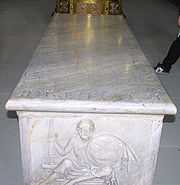
Pope Clement II
Pope Clement II , was Pope from December 25, 1046 to his death. He was the first in a series of reform-minded popes from Germany.Born in Hornburg, Lower Saxony, Germany, he was the son of Count Konrad of Morsleben and Hornburg and his wife Amulrad.In 1040, he became Bishop of Bamberg...
(1005–47) is buried in the Bamberg Cathedral. He was the local bishop before he became Pope in 1046, but he died already in 1047 after having been pope for only twelve months. Bamberg Cathedral is the site of the only papal burial outside of Italy and France.
The organ
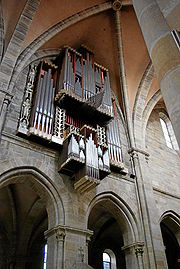
Keyboard instrument
A keyboard instrument is a musical instrument which is played using a musical keyboard. The most common of these is the piano. Other widely used keyboard instruments include organs of various types as well as other mechanical, electromechanical and electronic instruments...
and pedalboard. All the organs during the cathedral’s history were built against the north wall because the sound was best there.
Every year about 40 concerts are given in the cathedral.

